The 3,000-mile Great March for Climate Action will launch March 1st from the Los Angeles Harbor Area. Sherry Lear, San Pedro soccer mom, writes on the history of the community that has experienced debilitating effects from fossil fuel development, explaining why it’s a perfect place to march en masse for clean energy solutions. More Information: http://j.mp/GreatMarchWU
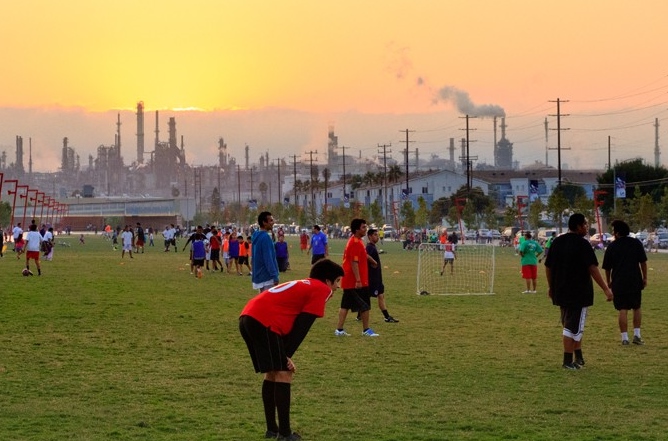

Why March in Wilmington?
By Sherry Anne Lear
On March 1, 2014, the Port of Los Angeles will be home to the Kickoff and Rally for the Great March for Climate Action, the largest coast to coast environmental march in US history. Originally, March organizers wanted to start their march in the iconic beach town of Santa Monica, CA. Local environmental activists convinced the organizers they should instead start the march in the Port of Los Angeles, home to a number of major oil refineries where over 650,000 barrels of crude are refined every day. The Port of Los Angeles is the major economic generator for Southern California and is also a major source of pollution, not just because of the business of refining itself but due to the numbers of vehicles coming in and out of the Port every day to keep it operating.
To their credit and to the gratitude of those of us who live in the Port area, the organizers of the Great March for Climate Action (GMCA) agreed to change their opening day plans and this historic event has now been moved to the Wilmington Waterfront Park. After a press briefing and rally starting at 8:30 a.m., marchers will head out at 10:00 a.m. for a 17.5 mile trek to USC/Exposition Park Area. This change is not without downside for the GMCA. Many Los Angelenos don’t even know where Wilmington is located. This port community has no major public transportation outlet, leaving those who want to avoid traveling by car with the prospect of getting to Wilmington by bus, which can be a two-plus hour trip. Although very historically significant to the development of Los Angeles, Wilmington has no major tourist attractions and no shopping malls.
Why begin the Great March for Climate Action in the Port of LA? Wilmington has the largest concentration of refineries in the state, where over 650,000 barrels of crude are refined every day. Pollution also comes from oil drilling, ports, and diesel trucking.
All of these are only part of the reason those who care about climate change, environmental justice and the future of our planet should make the effort and undergo the inconvenience of joining the GMCA, So Cal Climate Action Coalition 350 and its regional partners, and the residents of the Los Angeles Harbor to change the hearts and minds of America and its elected leaders to act NOW to address the climate crisis.
History of Wilmington


Wilmington, which is part of the City of Los Angeles, is a port community known as the “Heart of the Harbor.” Wilmington dates its history back to a 1784 Spanish land grant. In 1843, at the age of 13, Phineas Banning went to work in his father’s Philadelphia law office. By 21, Banning left his East Coast home, sailed to Panama, crossed the jungles by mule and canoe, and then sailed 3,000 miles north and ended up landing at the shallow San Pedro Bay.
Soon after his arrival, Banning got into the business of staging and freighting, often driving six-horse stages over twenty miles. At this time, Los Angeles had no large river or deep water harbor. Banning had the vision to foresee a future in an area of mud fields and ultimately obtained the approval and funding to create the Port of Los Angeles, constructing the first breakwater and dredging the harbor.
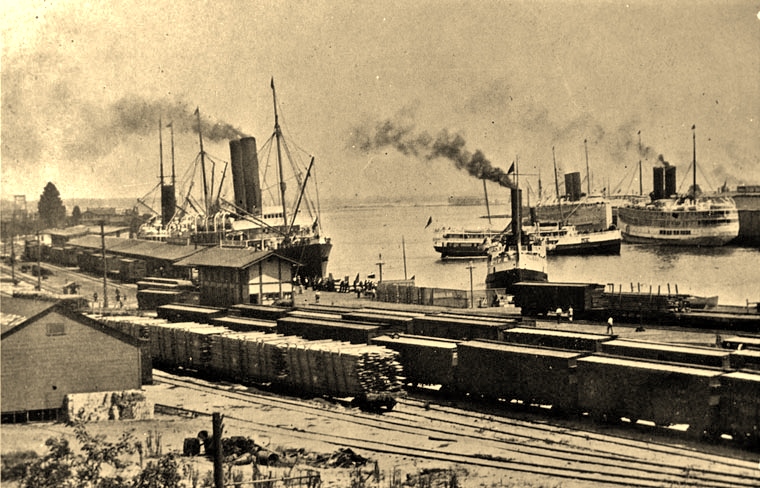

Without Banning’s foresight and perseverance, the City of Los Angeles as we know it today, would not exist. Originally known as “New San Pedro,” Banning named the town “Wilmington” in 1863 after his Delaware birth place. Banning is rightly known as the “Father of the Harbor.”
The City of Los Angeles, in recognition of the economic potential of the Port, annexed Wilmington and San Pedro in 1909, promising residents millions in investments in the Port and public improvements in their city. To this day, there are those in the Harbor who wish the vote had gone the other way.
Wilmington Today
Like neighboring San Pedro, Wilmington is a close-knit community where families have resided for many generations and Wilmington residents have a great sense of pride for their home town. Wilmington covers 9.14 square miles, features a heavy concentration of industry, and is home to over 54,000 people. Latinos made up 86.6% of Wilmington’s population, while 44.5% of its residents were born abroad. Approximately 5.1% of Wilmington residents aged 25 or older had a four-year degree in 2000 (a low figure when compared with the city and the county at large) and the percentage of those residents with less than a high school diploma is also higher than the rest of Los Angeles. Wilmington is home to 12 elementary schools, seven middle schools, four high schools (including Banning High School), 11 preschools and two community colleges (both public and private).
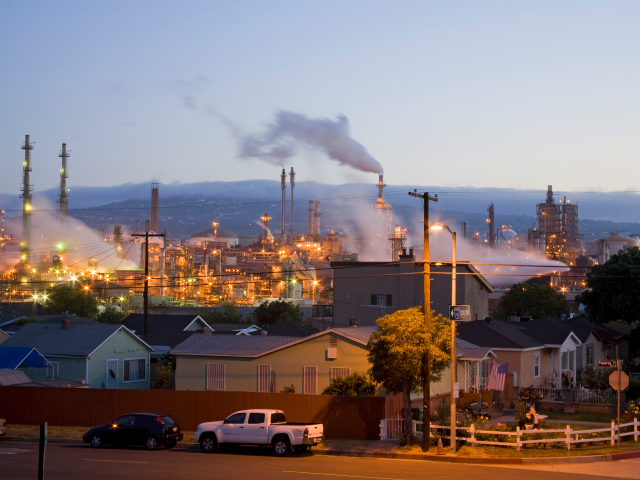

Wilmington is adjacent to the Wilmington Oil Field, discovered in 1932, the third largest oil field in the continental United States. Oil pumps dot the city, found in playgrounds, parking lots and church grounds. Wilmington is the home to four major oil refineries with two additional refineries bordering Wilmington to the north in the City of Carson and six petroleum industry bulk loading terminal facilities in the local area. Many of these facilities date back to the original oil strike. Refineries in Wilmington process close to 250,000 barrels of crude every day. As expected, many Wilmington residents work in the Port of Los Angeles. It is, in every sense of the word, a blue collar community.
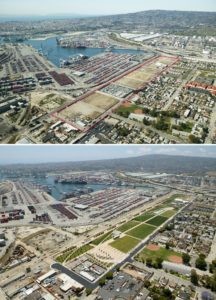

The Waterfront Park – An Exercise in Persistence
The Wilmington Waterfront Park is literally “across the street” (i.e. Harry Bridges Blvd.) from the bustling activity and multi-story cranes that operate 24 hours a day in the Port of Los Angeles. The park serves as a “buffer” area between Port operations and residential communities which dot “C” Street. It will be the gathering site of the LA Launch and Rally of the Great March for Climate Action on Saturday, March 1.
The original plan for the site was to put up a large wall on vacant land owned by the Port of Los Angeles. After years of activism, the people of Wilmington were able to convince the Port with the help of environmental groups like NRDC and Communities for a Better Environment, to construct a 30-acre park, which includes green space, picnic areas, a playground, water play spaces and fountains, restrooms, bike racks, pedestrian bridges, event plazas, viewpoints and trails for walking and biking. The before and after are pictured here. The Wilmington Waterfront Park is part of a series of improvements which have been made in the Los Angeles Harbor area, including the Fanfare fountains at San Pedro, a process which will continue for many years.
Wilmington: a Model for Environmental Injustice
The port community of Wilmington, along with nearby San Pedro and the Cities of Carson and Long Beach face very real issues with air quality and other pollutants due to Harbor activities. The ports of Los Angeles and Long Beach are sources of diesel and fugitive emissions from bulk transport activities by trucks, rail and ship.
Wilmington and nearby communities are known as “cancer alley” because of the high concentration of cancer, heart disease and asthma. Local teachers report that up to 25% of students suffer from asthma (compared to 9.5% nationally per the CDC). Wilmington residents suffer in disproportionate amounts from health issues, including asthma attacks and breathing problems, caused by toxic releases from refineries in their communities, some of which are located less than one mile from public schools and public housing. Because Wilmington is a lower-income community, these problems are often ignored or go unreported in main stream media. Yet, they persist.
Valero Energy seeks permits for large-scale shipments of low-quality tar sands oil via rail into their Port of Los Angeles refinery [now on hold]. As part of a larger move to transport climate-disrupting unconventional crude to ports for refining and export to the world, it presents dangers given recent rail accidents, the corrosive nature of tar sands bitumen, and the significant pollution that surrounding communities already live with. Read More…
Of course, air quality and health issues are not just limited to Wilmington and the Harbor area. Numerous health studies, including a decade-long study by the South Coast Air Quality Management District, have shown that residents near major roadways and ports suffer more severe health problems than people who live elsewhere. Children have a greater risk of impaired lung function; babies are more likely to be born prematurely or with lower weights. Near major transportation routes, the risk of cancer is higher due to diesel exhaust and other air contaminants. Around the world, fine particles generated by vehicles and industry have been linked to increased deaths from heart attacks and lung diseases.
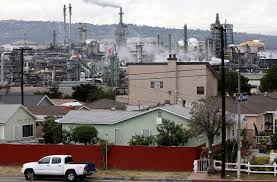

It is a reality that the poor and people of color find themselves living near these toxic areas. About 56% of the nine million Americans who live in neighborhoods within three kilometers of large commercial hazardous waste facilities are people of color, according to a 2007 environmental justice report by the United Church of Christ. In California, this number is 81%. Poverty rates in these neighborhoods are 1.5 times higher than elsewhere.
Of course, toxic pollution from oil refineries doesn’t stay outside; it seeps into homes, where people spend most of their time. Each year, pollution from ships, trucks and trains that move goods through the Port of Los Angeles region contributes to an estimated 2,100 early deaths, 190,000 sick days for workers, and 360,000 school absences, according to the California Air Resources Board. In other words, communities like Wilmington are literally paying – sometimes with their lives – for our fossil fuel addiction.
While California is moving toward more renewable energy, there is little chance that the refineries in the Ports of Los Angeles and Long Beach are going to close or slow down any time soon. Petroleum based fuels still account for over 90% of the State’s transportation needs. With the recent energy boom in North American brought on by fracking for natural gas and the processing of tar sands oil, California is now exporting dirty fuels overseas even as our state builds more and more solar and wind powered plants to fuel our own homes.
If we are really serious about our demands that we move away from fossil fuels and to clean energy, then we need to go directly to those communities most directly affected by our short-sighted energy policies and be willing to literally get “in the face” of those companies that are hurting the most vulnerable members of our community. That is why Wilmington is the perfect place to start the Great March for Climate Action. Standing in front of palm trees on beach full of tourists isn’t going to cut it. We must do more.
My Personal Plea
Many in the environmental community come from more affluent areas that don’t suffer from the air quality and health issues that those of us who live in the Harbor face every day. Some of my activist friends drive expensive hybrid or electric cars and enjoy expensive organic produce. In the meantime, my son has developed asthma since we moved to San Pedro. No one on either side of our family has a history of asthma. Climate change for my family is, indeed, personal.
Don’t get me wrong, I love my community. But we can’t keep fighting big oil and the energy industry alone. We need help. I have gone to many rallies all over Los Angeles and, finally, it is time for the environmental community to come en masse to the Harbor and stand up for Clean Energy and Against Dirty Fossil Fuels. So, please join the people of the Los Angeles at the March 1 Kickoff and Rally for the Great March for Climate Action. You won’t regret it. And the residents of Wilmington, San Pedro and surrounding communities will thank you.










Pingback: Climate Action March
Pingback: Hundreds Launch National Climate March from the Port of LA | WilderUtopia.com
Pingback: Hands Across the Harbor: LA Residents Protest Dirty Fossil Fuels in Port | WilderUtopia.com
Pingback: Hands Across the Harbor
Pingback: Call to Action California: How to Solve the Climate Crisis | WilderUtopia.com
Pingback: SoCal 350 Climate Action – SoCal 350 Climate Action History